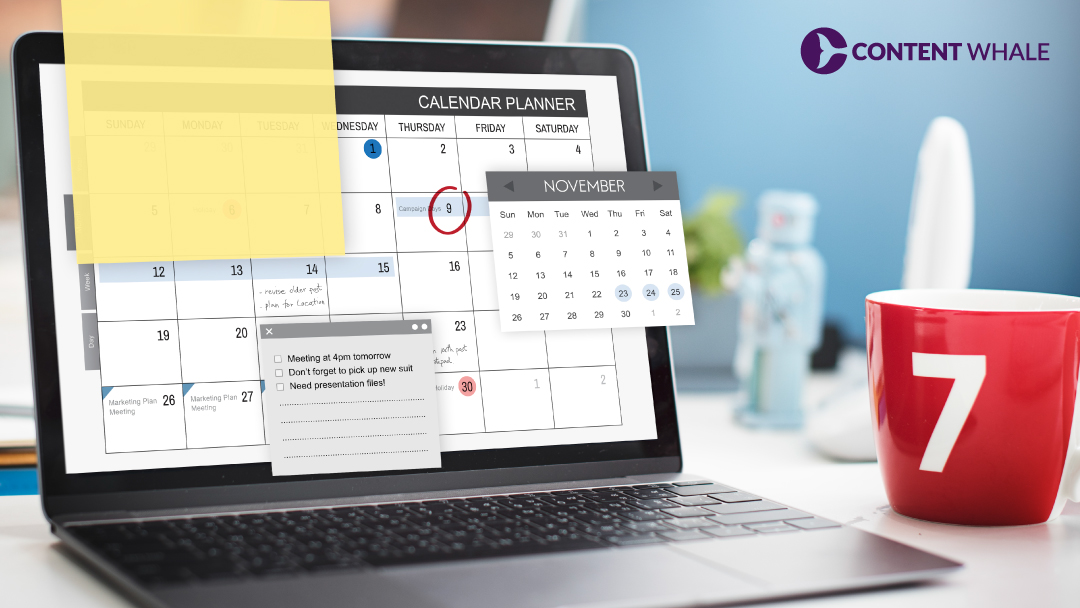Quick Summary
Seasonal marketing leverages specific times of the year to engage consumers, boosting visibility and sales. To create effective seasonal marketing content, plan with a marketing calendar that highlights key dates. This ensures your campaign planning aligns with consumer interests and trends. Well-executed seasonal campaigns increase engagement and drive sales by delivering timely and relevant content. Content Whale can support your business with expert strategies and execution for successful seasonal marketing.
Seasonal marketing content leverages the unique appeal of specific times of the year to engage consumers more deeply. As seasons change, so do consumer behaviors and preferences, creating opportunities for businesses to connect in meaningful ways.
This type of marketing is especially potent because it aligns promotional messages with the natural tendencies and current interests of consumers.
A well-defined marketing calendar is essential in this context, serving as a strategic guide for when and how to launch these timely campaigns. By planning ahead with a marketing calendar, companies ensure they don’t miss key dates that are critical to their marketing success.
Effective campaign planning allows businesses to anticipate resources needed, align team efforts, and set clear objectives, making each seasonal campaign more targeted and effective.
This blog focuses on creating a strategic approach to seasonal marketing content. From understanding the significance of seasonality in marketing to actual campaign execution, the insights shared here will help marketers maximize their impact throughout the year.
Understanding Seasonal Marketing

Seasonal marketing content taps into consumer excitement around holidays and changes in seasons. It offers marketers a chance to present their products as part of seasonal celebrations or needs. For example, promoting beach gear in summer or hot chocolate during winter leverages the season’s specific appeal. This method can boost visibility and sales during high-traffic times.
Understanding the principles of seasonal marketing is the first step. It revolves around knowing when your products or services can meet seasonal demands. Marketing calendar planning is vital here. By mapping out key dates and seasons, marketers can prepare compelling content that resonates with the moment.
Successful seasonal campaigns require meticulous campaign planning. This involves selecting the right mix of marketing channels and timing your message to break through the noise. The goal is to ensure your seasonal marketing content is ready to deploy before the season arrives, capturing interest at its peak.
Identifying Key Seasons for Your Business

1. Analyzing Your Business and Industry Trends
To identify the best times for seasonal marketing content, start by analyzing your business and industry trends. Look at past sales data to see when your products or services are in high demand. Understanding these patterns helps tailor your marketing efforts to meet seasonal demands effectively.
For example, examining the previous year’s data can reveal spikes during specific holidays or events, enabling you to plan better for the future.
2. Identifying Key Seasons and Events
Identify key seasons and events relevant to your audience. This includes major holidays, industry-specific events, or local festivities. Knowing these dates allows you to plan your seasonal marketing content effectively, ensuring you target your audience when they’re most receptive.
For instance, leveraging key dates like Black Friday, Valentine’s Day, or industry-specific events can boost engagement and sales significantly.
3. Creating a List of Priority Seasons
Make a list of priority seasons to target. Rank them based on their potential impact on your business. Use a marketing calendar to plot these dates and outline your campaign planning. This ensures you’re ready to launch campaigns at the right times, maximizing your engagement and sales.
Tools like Google Calendar, Trello, or specialized marketing software can help streamline this process by providing templates and reminders for key dates.
By incorporating these detailed steps, your seasonal marketing content will be more strategic and effective, ensuring that you capitalize on the peak times relevant to your business.
Developing a Marketing Calendar

A marketing calendar is essential for effective campaign planning. It helps you schedule and manage your seasonal marketing content strategically. Start by mapping out key dates and seasons that are relevant to your business and audience. Include major holidays, industry-specific events, and local festivities.
1. Steps to Create an Effective Marketing Calendar
I) Identify Key Dates and Seasons
List all significant dates and seasons for your industry. Use historical data to determine high-demand periods. This helps you prioritize and plan your campaigns ahead of time.
II) Plan Content Themes
Assign specific themes and content types to each key date. For example, plan blog posts, social media updates, and email campaigns around these themes. Ensure your seasonal marketing content aligns with these themes to maintain consistency.
III) Allocate Resources
Determine the resources needed for each campaign, including budget, team members, and tools. Efficient campaign planning involves ensuring that all necessary resources are available well in advance.
IV) Set Deadlines
Establish clear deadlines for each phase of your campaign. From content creation to approval and distribution, setting deadlines helps in staying on track and avoiding last-minute rushes.
2. Tools and Templates to Streamline Your Planning
Several tools can help streamline your campaign planning process:
- Google Calendar: A versatile tool for scheduling and reminders. Share it with your team to ensure everyone is on the same page.
- Trello: Use Trello boards to manage tasks and deadlines. Create lists for each campaign stage, and move tasks as they progress.
- CoSchedule: An all-in-one marketing calendar that integrates with your content management systems. It helps in planning, executing, and measuring your campaigns.
3. Importance of a Marketing Calendar
A well-structured marketing calendar ensures that your seasonal marketing content is timely and relevant. It aids in resource management, ensuring that all team members know their responsibilities.
Effective campaign planning reduces stress and enhances the overall impact of your marketing efforts. By preparing ahead, you can capitalize on peak seasons, drive engagement, and boost sales.
Crafting Compelling Seasonal Content

Creating engaging seasonal marketing content involves tailoring your message to the specific time of year. This ensures your content resonates with your audience’s current interests and needs. Here are some effective strategies for crafting compelling seasonal content.
1. Types of Seasonal Content
I) Blog Posts
Write blog posts that address seasonal trends or provide tips relevant to the season. For example, create a guide on holiday gift ideas or summer travel tips. These posts can drive traffic and engagement during peak seasons.
II) Social Media Updates
Use social media to share timely and relevant updates. Create posts that highlight your seasonal promotions, special offers, or seasonal product features. Visual content, such as photos and videos, can significantly increase engagement.
III) Videos
Videos are highly effective for seasonal marketing content. Create tutorials, behind-the-scenes looks, or customer testimonials that align with the season. For instance, a cooking video featuring holiday recipes can attract significant attention during the festive season.
2. Tips for Creating Engaging Content
I) Leverage Seasonal Themes
Incorporate seasonal elements into your content. Use colors, symbols, and themes associated with the current season. This helps create a strong emotional connection with your audience.
II) Highlight Limited-Time Offers
Emphasize the limited availability of seasonal promotions or products. This creates a sense of urgency and encourages quick action from your audience.
III) Tell a Story
Craft narratives that resonate with the season. Share stories about how your products enhance seasonal experiences or solve seasonal challenges. This storytelling approach can make your content more relatable and engaging.
3. Examples of Successful Seasonal Content
I) Starbucks: Holiday Season Campaign
Starbucks’ holiday season campaigns are legendary. Their introduction of the “Red Cups” during Christmas has become an annual tradition that customers eagerly anticipate.
These cups symbolize the festive season, creating immense buzz each year. Starbucks leverages social media, in-store promotions, and limited-time offers to engage customers, driving sales and enhancing brand loyalty.
II) Amazon: Prime Day
Prime Day is Amazon’s mid-year sale event, typically taking place in July. It offers exclusive deals and promotions, driving significant sales and increasing revenue.
Popular items during Prime Day include electronics, home appliances, and fashion products. Amazon sellers use this opportunity to offer limited-time deals, boosting visibility and attracting new customers.
III) Taco Bell: Costume Contest
Taco Bell’s Halloween costume contest encourages customers to dress up in Taco Bell-themed costumes. Participants share their photos on social media, using specific hashtags and tagging the brand.
This user-generated content campaign creates buzz and engagement, helping Taco Bell connect with its audience in a fun and interactive way.
IV) Melvin & Hamilton: Easter Egg Hunt
Melvin & Hamilton created an online Easter egg hunt, encouraging visitors to their online shop to look for hidden Easter eggs. Finding an egg gave customers a 10% voucher, with an additional prize for using the voucher within 30 days.
This campaign boosted engagement and sales by making the shopping experience interactive and rewarding.
V) Allswell: Mother’s Day Promotion
Allswell promoted their beds and mattresses for Mother’s Day, playing on the idea that moms just want to relax. They used survey results to back up their promotions, offering discounts on products that would make great Mother’s Day gifts.
This campaign effectively targeted the emotional aspect of Mother’s Day, boosting sales and brand recognition.
VI) Wayfair: Independence Day Sales
Wayfair’s Independence Day campaign features discounts on patriotic-themed items such as flags, banners, and outdoor gear.
They create visually appealing ads with patriotic colors and symbols, capturing customer attention and driving sales during the holiday.
These examples demonstrate the effectiveness of well-planned seasonal marketing campaigns. By aligning promotions with consumer interests and leveraging strategic timing and creative engagement tactics, brands can significantly boost their visibility and sales during key seasonal periods
4. Tools for Crafting Content
- Canva: Use Canva to design eye-catching graphics and visuals for your seasonal campaigns. It offers templates and design tools tailored for different seasons.
- Adobe Spark: Create stunning videos and social media content with Adobe Spark. It provides easy-to-use features for adding seasonal effects and themes.
- Buffer: Schedule and manage your social media posts with Buffer. Plan your seasonal marketing content in advance to ensure timely and consistent posting.
Creating engaging seasonal marketing content requires thoughtful campaign planning and the use of a marketing calendar.
By leveraging the right tools and strategies, you can capture your audience’s attention and drive significant engagement during key seasonal periods.
Promoting Your Seasonal Campaigns

Promoting your seasonal marketing content effectively requires a multi-channel approach. Use various platforms to reach your audience where they spend their time. Here are some strategies to maximize the impact of your seasonal campaigns.
1. Strategies for Multi-Channel Promotion
Social Media Campaigns: Leverage platforms like Instagram, Facebook, and Twitter to promote your seasonal content. Create engaging posts, stories, and videos that highlight your seasonal offers and drive traffic to your website.
• Email Marketing: Send targeted emails to your subscribers featuring your seasonal promotions. Use segmented lists to tailor messages to specific audience groups. Include clear calls-to-action and links to your seasonal products or landing pages.
• Paid Advertising: Invest in paid ads on social media and search engines. Use seasonal keywords and attractive visuals to capture attention. Paid ads can boost visibility and drive conversions quickly during key seasonal periods.
2. Integrated Marketing Campaigns
An integrated approach ensures consistency across all channels. Coordinate your campaign planning to align messages and visuals. This creates a seamless experience for your audience, reinforcing your seasonal theme.
• Unified Messaging: Ensure your messaging is consistent across all platforms. Whether it’s social media, email, or ads, maintain the same tone and style to strengthen your brand’s seasonal narrative.
• Cross-Promotion: Promote your seasonal content on all available channels. Share your blog posts on social media, include links in your emails, and reference your promotions in paid ads. This amplifies your reach and reinforces your message.
3. Using Email, Social Media, and Paid Ads Effectively
• Email Marketing: Use a marketing calendar to plan your email campaigns. Schedule emails to go out at optimal times, such as a few days before a holiday or event. Personalize emails to increase engagement and include exclusive offers to incentivize action.
• Social Media: Post regularly about your seasonal promotions. Use hashtags, engage with followers, and create shareable content. Run social media contests or giveaways to increase engagement and spread your message.
• Paid Ads: Allocate budget for targeted ads. Use platforms like Google Ads and Facebook Ads to reach specific demographics. Monitor ad performance and adjust strategies based on real-time data to maximize ROI.
4. Examples of Effective Promotion
Here are some examples of successful seasonal marketing campaigns that illustrate diverse strategies and creative approaches:
I) Hilton Hotels: #HiltonStayFor10 TikTok Campaign
Hilton Hotels launched a unique 10-minute TikTok video featuring influencer Paris Hilton and other creators. This campaign leveraged the popularity of TikTok to create engaging, long-form content that took viewers on a journey.
The campaign cleverly used influencers’ voices and styles, making it relatable and engaging. The use of a long video format on TikTok was supported by audience insights showing that a significant portion of their target audience engages with long-form content
II) Patagonia: Mission-Led Content
Patagonia focuses on promoting environmental and social causes rather than its products. Their campaigns often feature content related to environmental activism, such as short films on the importance of recycling and the impact of dams on greenhouse gas emissions.
This approach builds strong brand loyalty by aligning with the values of their audience. Patagonia’s commitment to these causes, such as their decision to boycott Facebook ads, demonstrates the power of mission-driven marketing.
III) Heinz: Red HTK 57 Paint Collaboration
Heinz collaborated with Lick, a home décor brand, to create a limited-edition paint color matching their iconic ketchup. This imaginative brand extension was marketed during the summer BBQ season, aligning with consumer interests in both grilling and home improvement.
This creative approach not only drew attention to Heinz but also resonated with DIY enthusiasts, highlighting the potential of product collaborations.
Promoting seasonal marketing content requires careful campaign planning and the use of a marketing calendar. By integrating your efforts across multiple channels and maintaining consistent messaging, you can maximize the impact of your seasonal campaigns and achieve significant results.
Measuring Campaign Success

Tracking the success of your seasonal marketing content is essential to understand its impact and to refine future campaigns. Here are key metrics and tools to help you measure the effectiveness of your seasonal campaigns.
1. Key Metrics to Track
• Engagement Metrics: Monitor likes, shares, comments, and click-through rates on your content. High engagement indicates that your seasonal marketing content resonates with your audience.
• Conversion Rates: Track the percentage of visitors who take a desired action, such as making a purchase or signing up for a newsletter. This helps in assessing the effectiveness of your campaign planning.
• Sales Data: Compare sales figures before, during, and after the campaign period. An increase in sales during the campaign indicates success.
• Website Traffic: Analyze traffic to your website, especially to pages linked to your seasonal content. Increased traffic can be a sign of successful seasonal marketing content.
2. Tools for Monitoring and Analyzing Performance
• Google Analytics: Use Google Analytics to track website traffic, user behavior, and conversion rates. It provides detailed insights into how your audience interacts with your content.
• Social Media Insights: Platforms like Facebook, Instagram, and Twitter offer built-in analytics tools. These tools help you monitor engagement metrics and understand which content performs best.
• Email Marketing Software: Tools like Mailchimp and HubSpot offer detailed analytics on open rates, click-through rates, and conversions. They help in assessing the effectiveness of your email campaigns.
3. Adapting Your Strategy Based on Insights
• Review and Adjust: Regularly review the data collected from your campaigns. Identify which aspects performed well and which did not. Adjust your future campaign planning based on these insights.
• A/B Testing: Use A/B testing to compare different versions of your content. This helps in understanding what resonates best with your audience and refining your approach.
• Feedback Loop: Collect feedback from your audience through surveys or direct interactions. Use this feedback to improve your seasonal marketing content and strategies.
4. Examples of Metrics and Tools in Action
• REI: REI’s #OptOutside campaign is a notable example of effective metric usage. Launched on Black Friday, this campaign encourages people to spend time outdoors rather than shopping. REI tracks engagement through social media metrics and website traffic, allowing them to gauge the campaign’s impact and customer response. This data-driven approach helps them refine their messaging and strategy for future campaigns.
• Amazon: Amazon extensively uses A/B testing in their email marketing to optimize subject lines and content. This method helps them determine which variations generate higher open and click-through rates, leading to better overall performance of their email campaigns.
These examples illustrate how major brands effectively use metrics and tools to enhance their seasonal marketing campaigns.
By leveraging data from various sources, they can optimize their strategies, improve engagement, and drive better results.
Leveraging Content Whale for Your Seasonal Marketing

Content Whale specializes in creating and executing effective seasonal marketing content strategies. Our expertise ensures your campaigns are well-planned and executed, maximizing their impact during key seasons.
1. Introduction to Content Whale’s Expertise
Content Whale brings extensive experience in content strategy and creation. We understand the nuances of seasonal marketing content and how to tailor it to different industries. Our team crafts content that resonates with your audience and aligns with the seasonal trends, ensuring higher engagement and conversions.
2. Affordable and Quality Services
We offer a range of 30+ services that are both affordable and of high quality. From content creation to campaign planning, we ensure your marketing calendar is filled with engaging and relevant content. We have our services starting from just 0.04$ per word.
Our goal is to provide value without compromising on quality, making us a preferred partner for many businesses.
3. Examples of Successful Seasonal Campaigns Managed by Content Whale
• Holiday Promotions: We helped an e-commerce client boost their holiday sales by 40%. Our strategy included themed blog posts, engaging social media content, and targeted email campaigns. This holistic approach ensured maximum visibility and conversions during the peak shopping season.
• Summer Sales: For a retail brand, we developed a summer campaign that increased their website traffic by 50%. By creating vibrant and appealing seasonal marketing content, we captured the essence of summer and drove significant engagement.
• Back-to-School Campaigns: We assisted an educational services company in planning and executing a successful back-to-school campaign. This involved a series of informative blog posts, interactive social media contests, and special offers, leading to a 30% increase in enrollments.
4. How Content Whale Can Help Your Business
Partnering with Content Whale means leveraging our expertise to enhance your seasonal marketing content.
We handle everything from campaign planning to execution, ensuring your marketing calendar is strategically planned and flawlessly implemented. Our services help your business stay relevant and competitive throughout the year.
By working with Content Whale, you ensure your seasonal campaigns are impactful, timely, and engaging. Let us help you maximize your marketing efforts and achieve your business goals during key seasons.

A solid content strategy is essential for successful seasonal marketing content. By planning and executing well-timed campaigns, you can significantly boost engagement and sales. Using a marketing calendar and thorough campaign planning, you ensure that your seasonal campaigns are impactful and reach your audience at the right time.
Seasonal marketing provides opportunities to connect with your audience on a deeper level. By anticipating their needs and delivering relevant content, you can create lasting impressions and drive loyalty. This approach not only enhances your brand visibility but also increases your ROI during peak seasons.
Explore Content Whale’s services for expert guidance and support in crafting and executing effective seasonal marketing content strategies. Let us help you maximize your marketing efforts and achieve outstanding results throughout the year.
By following these strategies and leveraging professional support, your business can thrive in any season, making the most of every marketing opportunity.
FAQ
What is seasonal marketing and why is it important?
Seasonal marketing content aligns your promotional efforts with specific seasons, holidays, or events. This approach taps into consumers’ seasonal behaviors and interests, driving higher engagement and sales.
By planning your campaigns around these periods, you can create timely and relevant content that resonates with your audience.
How do I identify the best seasons for my business?
Analyze past sales data and industry trends to pinpoint high-demand periods. Use customer feedback and market research to identify key seasons relevant to your products or services.
A marketing calendar helps organize these dates, ensuring your campaign planning targets the most impactful times.
What tools can help with creating a marketing calendar?
Several tools can streamline your campaign planning:
- Google Calendar: For scheduling and reminders.
- Trello: To manage tasks and deadlines.
- CoSchedule: An all-in-one marketing calendar that integrates with your content management systems, helping plan, execute, and measure campaigns.
How can I measure the success of my seasonal campaigns?
Track key metrics such as engagement rates, conversion rates, sales data, and website traffic. Tools like Google Analytics and social media insights can provide detailed performance data.
Regularly review and adjust your seasonal marketing content based on these insights to improve future campaigns.
Why should I choose Content Whale for my seasonal content strategy?
Content Whale offers expert guidance in creating effective seasonal marketing content. Our services include detailed campaign planning and the use of a marketing calendar to ensure timely and relevant content.
We have a proven track record of successful seasonal campaigns, providing both affordability and quality. Let us help you maximize your marketing efforts and achieve outstanding results.





